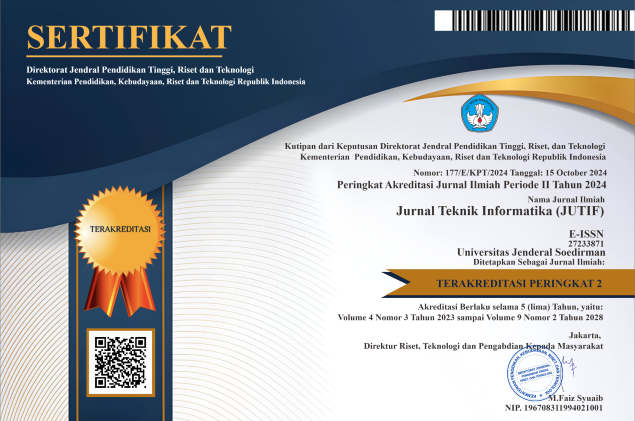Development of an AI Governance Model for Higher Education Using the Capability Maturity Model Integration (CMMI)
DOI:
https://doi.org/10.52436/1.jutif.2025.6.4.4709Keywords:
AI Governance Model, Artificial Intelligence, CMMI, DRM, Higher EducationAbstract
The increasing adoption of Artificial Intelligence (AI) in higher education presents strategic opportunities for institutional transformation, while introducing complex challenges related to ethics, accountability, transparency, and regulatory compliance. Responding to the growing complexity of AI implementation in academic environments , this study proposes a governance model for AI named GOVAIHEI (Governance of Artificial Intelligence for Higher Education Institutions), conceptualized using the Capability Maturity Model Integration (CMMI) framework. The model was developed using the Design Research Methodology (DRM), which consists of four stages: Research Clarification, Descriptive Study I, Prescriptive Study, and Descriptive Study II. GOVAIHEI encompasses five primary domains: Data and Information, Technology and Infrastructure, Ethics and Social Responsibility, Regulation and Compliance, and Monitoring and Evaluation. Each domain is articulated into capability areas and measurable practices, assessed using the tiered NPLF scale (Not, Partial, Largely, Fully Achieved) to determine institutional capability and maturity levels. The model was validated through expert judgment by three domain specialists, confirming its relevance, methodological soundness, and alignment with CMMI principles. A web-based evaluation system was also developed using Laravel, PostgreSQL, Redis, and Nginx, enabling structured, efficient, and automated assessments. Implementation in a case study at Institute XYZ revealed an initial maturity level (Level 1) with development goals toward Level 3 (Defined). The findings demonstrate a practical foundation for navigating the multifaceted nature of AI adoption in higher education through a structured and adaptable governance approach, which aligns with the increasing demand for robust digital governance frameworks in technology-driven environments.
Downloads
References
K. S. Salsabila, “8 Sistem AI di Berbagai Sektor untuk Mentransformasi Industri,” POINTSTAR. Accessed: Mar. 24, 2024. [Online]. Available: https://www.pointstar.co.id/artificial-intelligence/sistem-ai/
UNESCO, “Steering AI and Advanced ICTs for Knowledge Societies,” 2019. [Online]. Available: https://en.unesco.org/unesco-series-on-internet-freedom
UNESCO, Recommendation on the Ethics of Artificial Intelligence, no. November. 2021. doi: 10.7551/mitpress/14102.003.0010.
L. Floridi et al., “AI4People—An Ethical Framework for a Good AI Society: Opportunities, Risks, Principles, and Recommendations,” Minds Mach., vol. 28, no. 4, pp. 689–707, 2018, doi: 10.1007/s11023-018-9482-5.
J. Krijger, T. Thuis, M. de Ruiter, E. Ligthart, and I. Broekman, “The AI ethics maturity model: a holistic approach to advancing ethical data science in organizations,” AI Ethics, vol. 3, no. 2, pp. 355–367, 2023, doi: 10.1007/s43681-022-00228-7.
R. B. Sadiq, N. Safie, A. H. Abd Rahman, and S. Goudarzi, “Artificial intelligence maturity model: A systematic literature review,” PeerJ Comput. Sci., vol. 7, pp. 1–27, 2021, doi: 10.7717/peerj-cs.661.
K. Kanokngamwitroj and C. Srisa-An, “Personalized Learning Management System using a Machine Learning Technique,” TEM J., vol. 11, no. 4, pp. 1626–1633, 2022, doi: 10.18421/TEM114-25.
J. Huang, S. Saleh, and Y. Liu, “A Review on Artificial Intelligence in Orthopaedics,” Acad. J. Interdiscip. Stud., vol. 10, no. 3, pp. 206–217, 2021, doi: 10.23919/INDIACom54597.2022.9763178.
Personal Data Protection Commission - Singapore, Advisory Guidelines on Key Concepts in the Personal Data Protection Act, no. June. 2020.
Pemerintah Republik Indonesia, Undang- Undang Perlindungan Data Pribadi. 2022, pp. 1–50.
S. Bieletzke, “Ai Maturity Matrix – a Model for Self-Assessment and Categorization of Ai-Integration in Academic Structures,” EDULEARN24 Proc., vol. 1, no. May, pp. 1874–1881, 2024, doi: 10.21125/edulearn.2024.0559.
R. Selvaratnam and L. Venaruzzo, “Governance of artificial intelligence and data in Australasian higher education: A snapshot of policy and practice,” ASCILITE Publ., no. August, pp. 1–7, 2024, doi: 10.14742/apubs.2023.717.
B. Raharjo, Teori Etika Dalam Kecerdasan Buatan (AI), 1st ed. Semarang: YAYASAN PRIMA AGUS TEKNIK, 2019.
B. W. Wirtz, J. C. Weyerer, and C. Geyer, “Artificial Intelligence and the Public Sector—Applications and Challenges,” Int. J. Public Adm., vol. 42, no. 7, pp. 596–615, 2019, doi: 10.1080/01900692.2018.1498103.
A. Jobin, M. Ienca, and E. Vayena, “Artificial Intelligence: the global landscape of ethics guidelines,” Nat. Mach. Intell., 2019, [Online]. Available: http://arxiv.org/abs/1906.11668
BPPT, Strategi Nasional Kecerdasan Artifisial Indonesia 2020 - 2045. 2020. [Online]. Available: https://ai-innovation.id/server/static/ebook/stranas-ka.pdf
J. Mangundu, “Navigating Artificial Intelligence Governance : Insights from South African Higher Education IT Decision-Makers,” African J. Inf. Syst., vol. 17, no. 1, 2025.
UNESCO, “Harnessing the Era of Artificial Intelligence in Higher Education.”
S. Shailendra, R. Kadel, and A. Sharma, “Framework for Adoption of Generative Artificial Intelligence (GenAI) in Education,” IEEE Trans. Educ., pp. 1–9, 2024, doi: 10.1109/te.2024.3432101.
I. O. Ukeje, C. O. Elom, M. A. Ayanwale, C. C. Umoke, and S. O. Nwangbo, “Exploring an Innovative Educational Governance Framework: Leveraging Artificial Intelligence in a Stakeholder-Driven ‘Open Campus Model’ in South East Nigerian Universities,” Int. J. Learn. Teach. Educ. Res., vol. 23, no. 6, pp. 416–440, 2024, doi: 10.26803/ijlter.23.6.19.
C. Wu, H. Zhang, and J. Carroll, “AI Governance in Higher Education: Case Studies of Guidance at Big Ten Universities,” Futur. Internet, vol. 16, p. 354, Sep. 2024, doi: 10.3390/fi16100354.
Y. L. Ramdhani and K. Surendro, “Development of AI Governance Model in Enterprises Based on CMMI Model Structure,” 2022 Int. Conf. Inf. Technol. Syst. Innov. ICITSI 2022 - Proc., pp. 145–150, 2022, doi: 10.1109/ICITSI56531.2022.9970981.
U. Gasser and V. A. F. Almeida, “A Layered Model for AI Governance,” IEEE Internet Comput., vol. 21, no. 6, pp. 58–62, 2017, doi: 10.1109/MIC.2017.4180835.
B. W. Wirtz, J. C. Weyerer, and B. J. Sturm, “The Dark Sides of Artificial Intelligence: An Integrated AI Governance Framework for Public Administration,” Int. J. Public Adm., vol. 43, no. 9, pp. 818–829, 2020, doi: 10.1080/01900692.2020.1749851.
IMDA & PDPC, Model Artificial Intelligence Governance Framework Second Edition. Singapore, 2020. [Online]. Available: https://www.pdpc.gov.sg/-/media/files/pdpc/pdf-files/resource-for-organisation/ai/sgmodelaigovframework2.pdf
CMMI Institute, “Capability Maturity Model Integration (CMMI) for Development, Version 2.0,” https://cmmiinstitute.com/cmmi.
UNESCO, “Ethics of Artificial Intelligence | UNESCO,” Unesco.org. Accessed: May 16, 2024. [Online]. Available: https://www.unesco.org/en/artificial-intelligence/recommendation-ethics
Y. K. Dwivedi et al., “Opinion Paper: ‘So what if ChatGPT wrote it?’ Multidisciplinary perspectives on opportunities, challenges and implications of generative conversational AI for research, practice and policy,” Int. J. Inf. Manage., vol. 71, p. 102642, 2023, doi: https://doi.org/10.1016/j.ijinfomgt.2023.102642.
S. Russell and P. Norvig, Artificial Intelligence : A Modern Approach, Second. 1996. [Online]. Available: http://www.sciencedirect.com/science/article/pii/B9780121619640500091
W. D. Eggers, D. Schatsky, and P. Viechnicki, “AI-augmented government. Using cognitive technologies to redesign public sector work,” Deloitte Cent. Gov. Insights, pp. 1–24, 2017, [Online]. Available: https://www2.deloitte.com/content/dam/insights/us/articles/3832_AI-augmented-government/DUP_AI-augmented-government.pdf%0Ahttps://www2.deloitte.com/content/dam/insights/us/articles/3832_AI-augmented-government/DUP_AI-augmented-government.pdf%0Ahttps://www
K. Siau and W. Wang, “Artificial Intelligence: A Study on Governance, Policies, and Regulations,” MWAIS 2018 Proceedings. 40, no. September, pp. 1–6, 2018, [Online]. Available: https://www.researchgate.net/publication/325934555
A. McGowan et al., “ChatGPT and Bard exhibit spontaneous citation fabrication during psychiatry literature search,” Psychiatry Res., vol. 326, p. 115334, 2023, doi: https://doi.org/10.1016/j.psychres.2023.115334.
F. Huang, H. Kwak, and J. An, “Is ChatGPT better than Human Annotators? Potential and Limitations of ChatGPT in Explaining Implicit Hate Speech,” in Companion Proceedings of the ACM Web Conference 2023, in WWW ’23 Companion. New York, NY, USA: Association for Computing Machinery, 2023, pp. 294–297. doi: 10.1145/3543873.3587368.
B. Bodo, N. Helberger, K. Irion, K. Z. Borgesius, and J. Moller, “Tackling the Algorithmic Control Crisis -the Technical, Legal, and Ethical Challenges of Research into Algorithmic Agents,” Yale J. Law Technol., vol. 19, no. 1, p. 51, 2018.
H. Waheed, S. U. Hassan, N. R. Aljohani, J. Hardman, S. Alelyani, and R. Nawaz, “Predicting academic performance of students from VLE big data using deep learning models,” Comput. Human Behav., vol. 104, no. November 2018, p. 106189, 2020, doi: 10.1016/j.chb.2019.106189.
S. A. D. Popenici and S. Kerr, “Exploring the impact of artificial intelligence on teaching and learning in higher education,” Res. Pract. Technol. Enhanc. Learn., vol. 12, no. 1, 2017, doi: 10.1186/s41039-017-0062-8.
IEEE, ETHICALLY ALIGNED DESIGN : A Vision for Prioritizing Human Well-being with Autonomous and Intelligent Systems, First Edition. 2019.
OECD, “Oecd Framework for the Classification of Ai Systems,” OECD Digit. Econ. Pap., vol. 323, no. 323, pp. 1–2, 2022, [Online]. Available: www.oecd.ai/wips.
E. COMMISSION, Commission Guidelines on prohibited artificial intelligence practices established by Regulation (EU) 2024/1689 (AI Act), vol. 1689. 2024.
S. Vincent-Lancrin and R. van der Vlies, “Trustworthy artificial intelligence ( AI ) in education : Promises and challenges,” OECD Educ. Work. Pap. No. 218, no. 218, p. 17, 2020, [Online]. Available: https://www.oecd-ilibrary.org/education/trustworthy-artificial-intelligence-ai-in-education_a6c90fa9-en
OECD, “OECD principles on artificial intelligence,” OECD. Accessed: Mar. 01, 2025. [Online]. Available: https://www.oecd.org/en/topics/ai-principles.html
OECD, “Regulatory sandboxes in artificial intelligence (AI) and other experimentation tools,” no. 356, pp. 1–39, 2023, [Online]. Available: http://www.oecd.org/termsandconditions.
UNESCO, AI and education: guidance for policy-makers. 2021. doi: 10.54675/pcsp7350.
UNESCO, “Closing Gender Devides In Digital Skill Through Education,” 2019.
K. UNESCO, “UNESCO sebut Indonesia negara super power bidang budaya – KWRI UNESCO | Delegasi Tetap Republik Indonesia untuk UNESCO,” kwriu.kemdikbud.go.id. Accessed: Dec. 13, 2023. [Online]. Available: https://kwriu.kemdikbud.go.id/berita/unesco-sebut-indonesia-negara-super-power-bidang-budaya/
UNESCO, “Teachers at the centre: The role and needs of Asia-Pacific teachers in addressing violence and school-related gender-based violence,” 2022.
Additional Files
Published
How to Cite
Issue
Section
License
Copyright (c) 2025 Irfan Walhidayah, Kridanto Surendro

This work is licensed under a Creative Commons Attribution 4.0 International License.



























